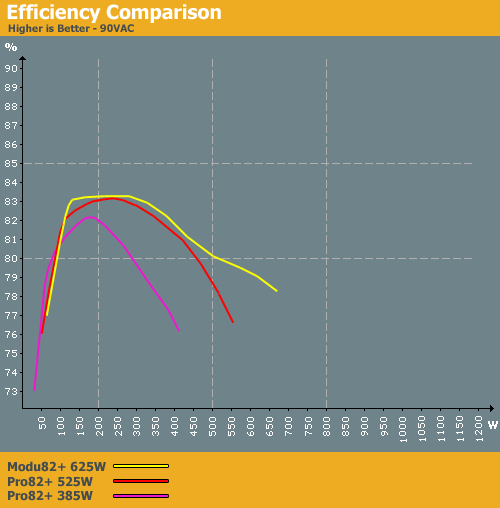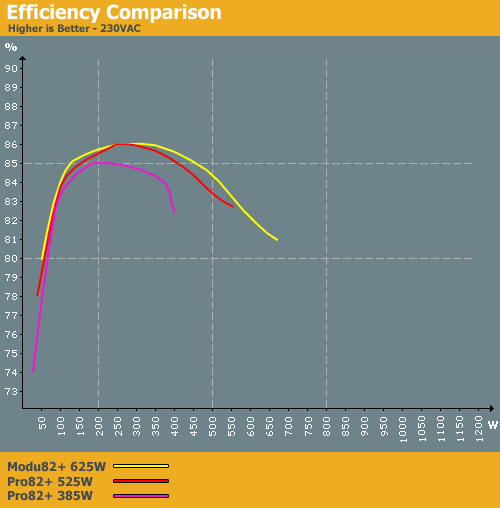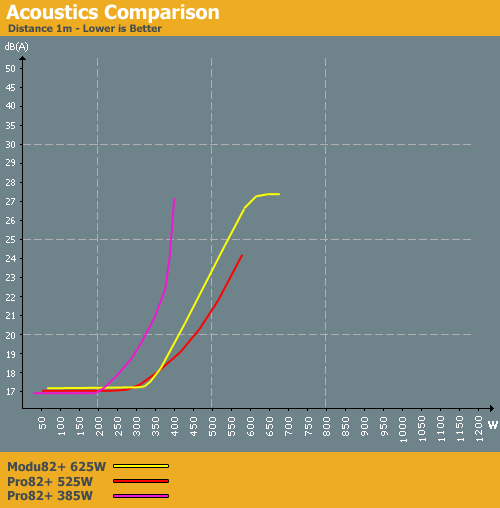Enermax Launches the Pro82+ and Modu82+
by Christoph Katzer on March 25, 2008 1:00 AM EST- Posted in
- Cases/Cooling/PSUs
Efficiency and Acoustics
One of the most important factors for an end-user in choosing a power supply is efficiency. Below we have three graphs that show the efficiency with 90, 120, and 230 VAC. The lower the input voltage is the lower the efficiency of the power supplies becomes; this is why the graphs on the last figure are much higher. We are calculating our loading chart according to Intel specifications of the latest ATX norm. However, we were asked to switch over to the 80Plus loading charts since more and more companies are using that now; rumors say that even Intel is using it already.
The difference between the specifications is that 80Plus is a more realistic calculation that loads the 12V rails much higher than the current Intel spec does. This results in higher efficiency ratings for starters. This is why our results don't quite match up with Enermax claims on their packaging; Enermax made that statement according to 80Plus tests.

At the lowest input voltage, the 625W Modu82+ performs very well with a very long period of high efficiency. The 385W performs the worst with a short summit of just 82% and 190W of load.

With 120VAC, the chart looks slightly different. Here we have the 525W version performing best and the power supply is able to come up with 84% at only 100W. It keeps this efficiency up to 400W and then slowly sinks. The small 385W version again performs worst and has only a short peak of 84% at 180W.

Finally, at 230VAC the graphs change again. As expected, the efficiency is much better. The 625W unit has a very nice and long lasting efficiency of over 85% from 100W of load. Even until full load of roughly 600W it keeps its efficiency high at a minimum of 82%. The 385W also performs well, but of course in a much smaller range. With only 50W of load, this power supply has 80% efficiency. It keeps efficiency above 82% even with 110% of load, which is a little more than 400W. These results clearly show the high performance of the tested units.
Acoustic Noise

The fan control unit is the same in all the units, and it regulates the fans according to the load of the power supply. All of the units stay totally silent with only 17dB(A) and 500 RPM until 50% of their load. The fan then starts turning faster and reaches 1500 RPM with maximum load applied to each unit. Only the 525W model doesn't quite reach 1500 RPM, topping out at 1300 RPM instead and thus creating less noise with only 24dB(A) with 110% load!
In general, these power supplies are simply not audible during normal use. The fans run at slightly less than 500 RPM, which is very slow. You can only hear the fan when you get your ear within an inch or two of the fan. You will then hear a sliding noise. Even at full load, 27dB(A) isn't very loud and will qualify as near-silent for most users. If you run a high-end graphics card or two, the fans on the GPUs will definitely drown out the noise of the power supply at any load.










17 Comments
View All Comments
Bremen7000 - Tuesday, March 25, 2008 - link
Horizontal bar charts for price? Really? I guess when all you have is a hammer...Woodchuck2000 - Thursday, March 27, 2008 - link
Well put...One of the shoddier reviews I've seen on Anandtech for quite some time, including some shocking graph abuse and grammatical errors throughout.
In the DC Output Stability and Quality section, There are four PSUs in the top three graphs and then only three shown in the analysis below. Which 525W supply is that?
In the graphs below, I assume the numbers at the lower half of the nonsensical Y-axis are meant to be negative? And is the load percentage on the X-axis a percentage of total rated PSU capacity, or rated line current. And in either case, are other lines loaded and if so how? You'd expect completely different 12v load characteristics depending on which other lines are loaded any how much.
"In case of ripple and noise, we were surprised to see very little distortion on the rails. The highest amount of ripple on the 12V rail was 16mV for example. The other rails were similar except the 5Vsb rail, which went a little high. That's pretty common, unfortunately."
Why is that surprising? How did you measure ripple? Is that amplitude or peak above rated? A little high under what circumstances? Why's that common, and if it's only the 5V Standby Rail, why is that necessarily unfortunate? The whole article is full of meaningless generalisations like that one...
Anandtech has enough quality writers not to need filler like this. All in all, D-
C'DaleRider - Tuesday, March 25, 2008 - link
Apart from the upgrade in caps, there seems to be no design improvements. On the contrary, the workmanship looks a bit dodgy. I'd wait to see if these blow up left right and center after a year of use before passing a verdict.
[quote]To our surprise, there are two main capacitors, which is something we don't see often in Enermax power supplies.[/quote]
Whaaaaa??? Last I checked the entire FMA lineup had "two capacitors" on the primary side.
Spacecomber - Tuesday, March 25, 2008 - link
At the beginning of the section on the Pro82+, you state, "The package is quite different from the Modu82+ series and comes in completely different dimensions". I think that you were just describing the dimensions of the box that the power supplies come in, but the picture at the start of the article, where the power supplies are stacked on each other, gives the impression that the power supplies themselves might be of different dimensions.Can you confirm that the external dimensions are the same for all these new models? Are these power supplies of the typical size?
Thanks.
Christoph Katzer - Tuesday, March 25, 2008 - link
Yes, only the package is different.strikeback03 - Tuesday, March 25, 2008 - link
Your photo of the label for the big Pro82+ shows 625W, but your charts on pages 12 and 14 say Pro82+ 525W. Which was it actually?Didn't look elsewhere, but these are on Newegg right now for $10-30 more than you list in the review. The Infiniti 650 is priced the same as the Modu82+ 625W but the Infiniti ships free, and the Infiniti 720W is cheaper than either after a $25 MIR.
Griswold - Tuesday, March 25, 2008 - link
Any good reason (like you couldnt get ahold of one) for not including the 425W PSU of this line? Its by far the most reasonable of the three... too bad.